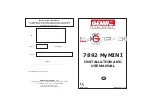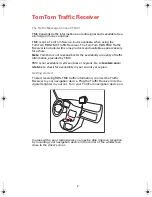
Advanced Operation
31
Advanced Operation
Daisy Chain Mode
The Daisy Chain mode establishes a communication link through the GPS receiver,
between a PC/handheld and a peripheral device. When the GPS receiver is in Daisy
Chain mode, all commands entering one serial port are passed back out through
another serial port. The commands are not interpreted by the GPS receiver. The
command $PASHS,DSY enables the Daisy Chain mode and allows the user to assign
which serial ports to be used. A typical example of the use of Daisy Chain mode is
communicating with a radio through a handheld. The radio and handheld are not
directly connected but are both connected to the GPS receiver via separate serial
ports. By enabling the Daisy Chain mode between the two serial ports used by the
handheld and radio, the handheld can communicate with the radio through the GPS
receiver. Refer to “$PASHS,DSY,x,y” on page 78.
Pulse Generation (1PPS) and Strobe
When the 1PPS [L] option is installed, the GG Surveyor provides the capability of a 1
pulse-per-second (1PPS) signal synchronized with receiver time. If the GG Surveyor
is set to use the GPS constellation, the 1PPS pulse synchronizes with GPS system
time. If it is set to use the GLONASS constellation only, the 1PPS pulse synchronizes
with GLONASS system time. If it is set to use a mixed constellation, it synchronizes
with the time selected by the TSC command (default is GPS system time).
The PPS signal is TTL-level into a 75-ohm impedance. 1PPS is generated by default
once every second with its rising or falling edge (selectable) synchronized to GPS or
GLONASS system time. Using the $PASHS,PPS command, the period of the PPS
may be changed from 0.2 second up to 999 seconds, depending upon the receiver
update rate; the PPS may be offset from the reference time with a resolution of 100
nanoseconds, and the synchronization edge can be set to rising or falling.
In order to provide notification to peripheral equipment and software with respect to
time tagging the instant of the 1PPS pulse, it is necessary to request the output of the
PBN raw data structure. The GPS system time contained in the PBN message plus
one second is the time of the next 1PPS pulse that occurs (Figure 4.6). This PBN time
is already internally rounded to GPS system time so it is the actual time to which the
navigation 1PPS pulse generation which preceded it (unless that pulse has been
Содержание GG Surveyor
Страница 14: ...xiv GG Surveyor GPS GLONASS Reference Manual...
Страница 38: ...20 GG Surveyor GPS GLONASS Reference Manual...
Страница 62: ...44 GG Surveyor GPS GLONASS Reference Manual...
Страница 86: ...68 GG Surveyor GPS GLONASS Reference Manual...
Страница 232: ...B 6 GG Surveyor GPS GLONASS Reference Manual...
Страница 236: ...C 4 GG Surveyor GPS GLONASS Reference Manual...
Страница 246: ...E 6 GG Surveyor GPS GLONASS Reference Manual...
















































